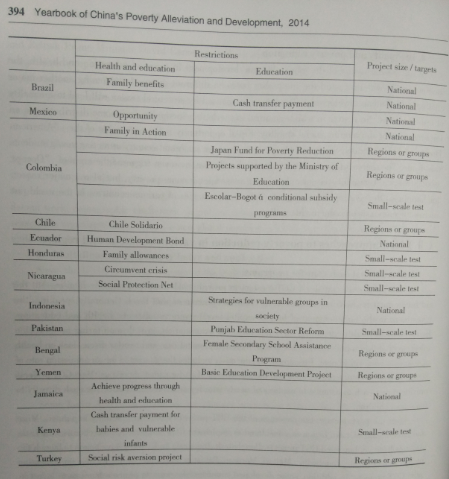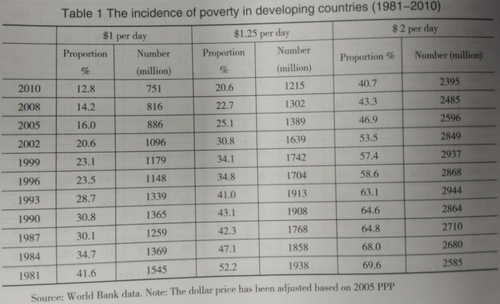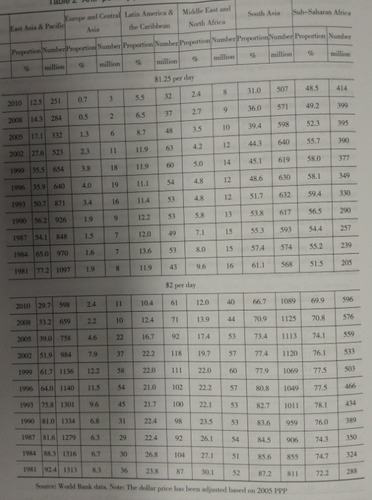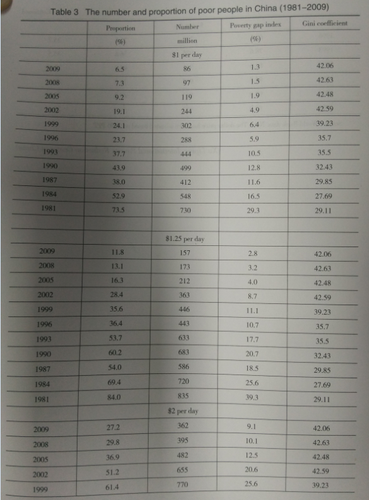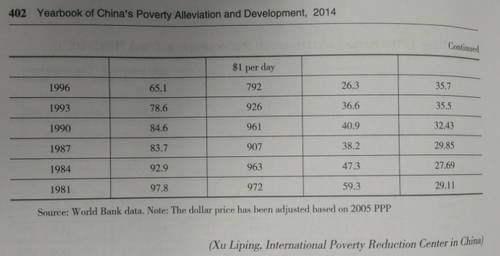Ⅸ. Urban Poverty Alleviation II
3. Climate change and poverty reduction
Human Development Report (2010) points out that more and more evidences have proved that the world’s environmental degradation is widespread and likely to deteriorate further, which are a serious threat to every country and region in the world. According to the estimates of Human Development Report 2011, by 2050, due to the “environmental challenges” including the adverse impacts of global warming and pollution on agricultural production, access to clean water and the improvement of health conditions, the Human Development Index will be 8% lower than the reference value (12% in South Asia and sub-Saharan Africa).
In recent years, along with climate change, many new types of disasters have appeared, the disaster losses are increasing and human society is facing increasing potential risks. In case of more serious situation of “environmental disaster” (such as a large area of deforestation, land degradation, a sharp reduction in biodiversity and more frequent extreme weather disasters), the global human development index will be 15 percentage points lower than the predicted reference value.
4. Inequality and poverty reduction
With the narrowing of the gap in human development in terms of education and health, the
income gap is widening, and the inequality between different groups is becoming another major challenge for human development. The inequality caused by structural reason will lead to inequality of opportunities. No matter in which country, exacerbating inequality in income distribution is an important factor threatening social stability. Equal opportunity is the core value of the “American Dream” and the United States has always been the most important country attracting young students worldwide. The increasing inequality of income distribution, however, triggered the event of “Occupy Wall Street”. Inequality is not only a main reason for income poverty, but also a major reason for happiness deprivation. Thus, poverty reduction strategies of various countries in the world put increasing emphasis on reducing inequality.
(Ⅱ)New approaches to poverty reduction in various countries and regions
1. Conditional cash transfer programs
Conditional cash transfer(CCT)refers to provide cash support for needy families but the
aid funds must be used to enhance their children's human capital level. Generally speaking, the investment in the enhancement of human capital level covers two aspects: health and education. Investment in health care covers regular physical examination, growth monitoring and vaccine injection of children under five years of age, maternal prenatal care and regular discussions on health care among lying-in women. Investment in education includes the guarantee for an admission rate of 80% and an attendance rate of 85% and the assessment of performance at campus. Most CCT projects provide direct cash assistance to mothers of needy families and sometimes issue the cash directly to the school children.
Over the past decade, the coverage of the CCT projects has been gradually expanded. More and more countries have begun or considered to implement CCT projects: All the countries in Latin America have implemented CCT projects. Bangladesh, Indonesia and Turkey have begun to launch the project in large scale. Cambodia , Malawi, Morocco, Pakistan and South Africa are also implementing pilot CCT projects. In addition, some developed countries also want to promote families to invest in children’s education through the program. Big cities such as New York and Washington have begun to launch the program.
In some Latin American countries where the phenomenon of inequality is severe, CCT project is regarded as an effective way to reduce social inequality, help break the vicious cycle of intergenerational transmission of poverty, improve children’s health level, nutritional status and enrollment rate and promote the realization of the Millennium Development Goals. Brazil, Mexico and other middle-income countries have achieved good results in poverty reduction, such as Brazil’s “Family Benefits” and Mexico’s “Opportunity”.
Currently, the Tanzanian government plans to expand the conditional cash transfer projects for poverty alleviation. The Tanzanian government extended the validity of the Tanzania Social Action Fund III (TASAF III) for five years to support 1.2 million poor families living below the poverty line. The project is expected to help 275,000 families in the first year. Through the community-based CCT poverty reduction program, TASAF III will help needy families (mainly children and the elderly) to get access to social services. The World Bank has issued $ 220 million to support the project.
The Britain provides cash subsidies for the poorest of Pakistan through Benazir Income Support Programme. Britain supports Benazir Income Support Programme to provide monthly cash subsidy of 1000 rupees (about $ 7) for the poorest housewives to purchase necessities of life such as food and medicines, and support their children to go to school. In addition, if these mothers have children in elementary school, each child (at most three) can get financial aid of 200 rupees. These payments will be increased to 1,200 rupees (about $ 8) in September 2013. In 2012, the British supported Benazir Income Support Programme to provide cash transfer for 235,000 Pakistan families, and this figure may reach 441,000 by 2020.
2. Agriculture projects
Agricultural cooperatives projects in Ethiopia. Since 1999, with support of the US Agency for International Development, the Ethiopian government began to promote the implementation of agricultural cooperatives in Ethiopia (ACE) projects. Up to now, ACE projects have benefited a total of 50,000 people. The project includes cooperatives training at all levels for farm owners, co-directors, management personnel of the government and associations. Labor unions have been set up for the cooperatives to help them go global. 84% of the farmers who participated in the project said that their children will get the opportunity to continue their studies at abroad and 67% of the farmers said that their housing conditions have been improved. Cameroon launched the agricultural development supporting projects. Cameroon Ministry of Agriculture and Rural Development officially launched the Agricultural Development Support Project (PADFA) in Maroua City on July 31. The project construction will be completed by 2017, covering the northern region, north polar region, the western region and northwest region, aiming at increasing rice and onion production and improving the conditions for agricultural processing, storage and commercialization. The project has a total investment of about 12 billion CFA francs, of which 77.4% came from International Fund for Agriculture Development (IFAD), 14.1% from the government of Cameroon and 8.5% from the beneficiary farmers.
Cambodia’s private rubber plantations grew well and played an important role in promoting the development of household economy and reducing poverty. In 2013, Cambodia witnessed leapfrog development and entered into the rank of low and middle-income countries from a low-income economy. Therefore, the state needed to implement the “Multiple Development Policy” to continuously promote economic and social development. While attracting foreign investment, it encouraged domestic companies to invest in agriculture and other fields and to participate in economic development and job creation. Cambodian Prime Minister Hun Sen pointed out that the development of rubber plantations has four advantages: First, bring national income and household income and help reduce poverty; second, create jobs, maintain the stability of local people’s lives and reduce labor migration; third, provide timber for furniture production and construction industry, reducing deforestation; fourth, create green vegetation and prevent soil erosion, and is environmentally-friendly. Royal Government of Cambodia is developing a series of policies for the development of rubber industry, including the provision of small loans to promote the development of rubber industry of small families.
3. Social policy
Angola: Social assistance has played a crucial role in reducing poverty. Angola held a national conference on social assistance from October 21 to 23, 2013, pointed out that based on the current socio-economic development situation, social assistance plays a key role in promoting equity, reducing poverty and strengthening social cohesion. The draft national policy on social assistance announced by the conference points out: In the new context, the prominent challenge facing Angola is to reduce the vulnerability of the poorest, ensure their development and participation in economic growth process and promote the enhancement of social cohesion of Angola.
Hong Kong Committee on Poverty Reduction launched new aid projects to support the disabled poor. On July 22, 2013, Hong Kong Committee on Poverty Reduction approved four new aid projects worth HK $ 1 billion to support the severely physically handicapped, students from needy families and low-income people with harsh living environment. It is estimated that the project will benefit 560,000 people. The conference determined the subsistence allowance standard of HK $ 3,500 for each one-person household, HK $ 7,000 for each two-person household and HK $ 10,000 for each household with three or more members. The project will be launched by the end of this year and will cover about 200,000 people.
4. Adjustment of pro-poor strategy
Rwanda adjusted the pro-poor strategies. On September 13, 2013, the Rwandan government announced the official launch of Phase II strategy for economic development and poverty reduction. According to the strategic plan, Rwanda will achieve an average annual economic growth rate of 11.5% in the five years from 2013 to 2018 and reduce the poverty rate to 30% or less. During the implementation of Phase I strategy for economic development and poverty reduction, Rwanda achieved an average annual economic growth rate of 8.2% and reduced the poverty rate by 12%.
Indonesia again launched new pro-poor policy. With the economic recovery and increasing government efforts on poverty reduction, in recent years, the number of poverty-stricken people in Indonesia maintains a declining trend. According to the latest data of the Indonesian Central Bureau of Statistics, as of September 2012, the number of poverty-stricken people in Indonesia dropped to 28.59 million, accounting for 11.66% of the total population. Eight years ago, however, this figure was 36.1 million, accounting for 16.6% of the total population. The latest indicator of the Indonesian government’s poverty reduction is to reduce the proportion of the poor to 8% by 2014. To this end, the Government of Indonesia again launched new policies such as the “overall planning on accelerating and expanding poverty alleviation”, the “national program for supporting self-reliance of society” and the “Hope Family Program”, and the central government has established the “National Leading Group for Accelerating Poverty Alleviation”.
5. Employment policy
The government of Pakistan launched new poverty alleviation and employment programs. The government increased financial funds for poverty alleviation and employment programs from 44 billion rupees to 75 billion rupees. The young prime minister training program provides annual trainings for the youth under 25 who have completed 16-year degree program and issues allowances of 10,000 rupees per person per month for the trainees. The prime minister micro-credit program is designed to provide financial aid for entrepreneurs of small and micro enterprises. The prime minister youth skills development program holds trainings for 25000 young people under 25 years of age to support them to engage in different industries.
6. Infrastructure construction
The African Development Bank plans to raise $ 100 billion for infrastructure construction in Africa. Approximately half of the funds will come from the foreign exchange reserves of 53 member states and the balance will be raised worldwide. The funds will be invested in three years to support the construction of the Bagamoyo Port in Tanzania, the Lamu Port and the Mombasa - Rwanda Railway in Kenya, etc.
7. Urban poverty reduction
The UK and Canada jointly launched the study of urban security: It helps reduce urban poverty
to resolve violent conflicts. On September 16, 2013, “The Guardian” reported that the nadian International Development Research Centre and DFID jointly launched a project called “Safe and Inclusive City Initiative”. The project will invest $ 11 million in the investigation and analysis of the causes of urban violence in 40 cities in Africa, Asia and Latin America, trying to find an effective solution to the problem of urban conflict. Currently, more than 1.5 billion people worldwide live in violent conflicts and violent conflict has become a major obstacle to national development and poverty reduction.
8.Eradication of hunger
Among the Latin American countries, Mexico has the largest poverty-stricken population, and one third of the 168 million poor residents in Latin America live in Mexico. In 2010, 53.8% of the children and adolescents in Mexico lived below the poverty line, and this proportion of the indigenous children and adolescents reached 70%.
Mexico’s massive urbanization in the past led to serious polarization, particularly after Mexico joined the North American Free Trade Area in 1994, Mexico opened the door for US agricultural products, which was a huge blow to domestic agriculture. To reduce hunger and poverty, on January 21, 2013, Mexican President Pe.a Nieto officially announced the launch of the “national campaign against hunger and extreme poverty”. The six-year policy is designed to eliminate extreme poverty and address child malnutrition through creating a “food bank” and establishing nutrient supply system and related mechanisms rather than to directly distribute food and cash to the poor.
India has the largest poverty-stricken population in the world. One World Bank report points out that in 2010, India’s extremely poor people accounted for 33% of the total extremely poor people in the world, higher than the proportion of 22% three decades ago. In 2013, the Indian government launched a large-scale cash subsidy program - “Direct Benefit Transfer” (DBT) to help the poor in 20 regions nationwide. The program will issue more than 30,000 rupees (361.4 billion yuan) of funds to benefit at least 200,000 people at early stage and then it will cover the whole country by the end of 2013. The Indian government said that the ultimate objective of the program is to help the poorest in India to “enter the mainstream of society”.
9. World Bank Carbon Fund promotes the “Low-carbon Poverty Alleviation”
Green growth investment and financing is an important measure to achieve green growth and an important link for green growth to benefit the poor. Low-carbon financing is one of the green growth investment and financing modes with the best effect that is most widely used and develops best in the international arena. However, it is usually difficult for poor regions to participate in the low-carbon financing activities with the purpose of obtaining emission rights or making profits. To this end, the World Bank has been promoting the development of carbon funds.
At present, the World Bank Carbon Finance Unit (CFU) is responsible for the management of 12 carbon funds, including the Prototype Carbon Fund, the BioCarbon Fund, the Community Development Carbon Fund, the Forest Carbon Partnership Facility, etc. These funds were established through fundraising of OECD countries’ governments and companies and, based on the CDM and JI mechanism, provide financing services for the greenhouse gas reduction projects in developing countries and the countries with economies in transition.
At the Cancun Meeting held on December 9, 2010, the World Bank further presented the new idea of developing carbon finance and announced the establishment of the “Partnership for Market Readiness” (PMR) with a fundraising goal of $ 100 million. Different from other carbon funds of the World Bank, the PMR is not a purchaser of CERs, but aims to support the capacity building of domestic carbon trading system in various countries. As of October 2012, the PMR had absorbed about $ 80 million from 15 donation member countries. China has also joined the PMR and is actively exploring the feasibility of using domestic emissions trading system to reduce emissions. In addition, the PMR will continue to purchase carbon emission reduction after 2013, which is a positive sign to future carbon market in the context when the “Post-Kyoto” problem has not been addressed yet, indicating the World Bank’s expectation on the huge potential of carbon markets in various countries, providing confidence for developing countries to carry out “low-carbon poverty alleviation”.
10. China’s precise poverty alleviation
In order to implement the “China Rural Poverty Alleviation and Development Program (2011-2020)” and provide technical support for the poverty alleviation and development in the new stage, in May 2012, the Ministry of Science and Technology of PRC approved the implementation of the “key technologies for spatial information system of poverty alleviation and their application” as one of the national science and technology support projects. Project organizational unit was the State Council Leading Group Office of Poverty Alleviation and Development. In accordance with the theory of multidimensional poverty, the 12 major tasks determined by the “Outline” and the “Top Ten Actions” determined by the new government, the program developed precise identification methods such as the multidimensional poverty index, which can make a comprehensive judgment on the poverty degree of poor counties, villages and households and achieve precise identification of poverty-stricken people and precise anti-poverty effect monitoring and assessment according to poverty reduction needs, and can correctly identify the poverty relief objects of each of the “Top Ten Actions”. Meanwhile, the system can identify the poor in accordance with the standards of farmers’ net income poverty and can identify other dimensions of poverty, such as education. The system can clearly show the poverty degrees of the poor counties, poor villages and needy families make clear the causes of poverty. Making a breakthrough in poverty identification relying only on the economic indicator of “per capital net income of rural residents with the ability to work below the poverty line”, integrating the economic, infrastructure, public services, ecological environment and disaster risks, the system can conduct multi-dimensional multi-index evaluation to provide technical support for precise poverty identification and precise poverty reduction.
Ⅲ. Experience and implications
1. Multi-dimensional poverty identification and the development of multi-dimensional
poverty reduction strategies and policies
Continue to combat poverty in many areas. In terms of policy and planning, we should create more and better jobs, provide better education and health services, carry out infrastructure construction and protect vulnerable groups. As for poverty identification and measurement, we need to expand data collection and strengthen statistical capacity building.
2. Continue to strengthen China’s poverty reduction experience summarizing and
publicity
The United Nations and World Bank reports have both pointed out China has made a contribution to global poverty reduction, but seldom made clear which pro-poor policies and measures of China made a contribution to the global poverty reduction. We should continue to systematically sum up the experience of our poverty reduction, evaluate the effect of pro-poor policies and strengthen the publicity of our poverty reduction experience at abroad.
3. Include urban poverty into the national poverty reduction strategy
A bigger problem facing China’s poverty reduction is inequality and development gap. According to the experience of Latin American countries and South Korea, whether these problems can be effectively resolved will determine whether China can successfully enter the ranks of high-income countries. With the accelerated process of urbanization, urban poverty will become a more prominent problem. The existing urban employment policies, minimum living security policies and other assistance policies cannot completely cover the vulnerable in the city, especially the floating urban population without a registered household. We need to include urban poverty into the national poverty reduction strategy and adopt more targeted pro-poor measures to support the urban poor with the ability to work, which is of great significance to narrowing the development gap.
4. Strengthen the research of and the participation in the latest issues and agenda of
global poverty reduction
Such as the research on climate change and poverty reduction and the participation in the Post-Millennium Development Agenda.
Table 2 Anti-poverty progress in different regions (1981-2010)
Source: World Bank data. Note: The dollar price has been adjusted based on 2005 PPP
Table 3 The number and proportion of poor people in China (1981-2009)
Proportion
Source: World Bank data. Note: The dollar price has been adjusted based on 2005 PPP
(Xu Liping, International Poverty Reduction Center in China)
Continued

扫描下载手机客户端
地址:北京朝阳区太阳宫北街1号 邮编100028 电话:+86-10-84419655 传真:+86-10-84419658(电子地图)
版权所有©中国国际扶贫中心 未经许可不得复制 京ICP备2020039194号-2

